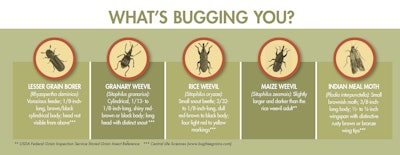
Since humans have practiced agriculture, we have been at war with the insects that eat and contaminate our harvested grain. Every year, millions of tons of grain are lost worldwide because of insects. While much of this loss happens in the field, a portion still occurs after the grain is stored despite the multiple ways to combat stored grain insects. In the Feed & Grain August/September 2022 issue, an infographic listing the most common stored grain insects and puts the damage they do in perspective. Much of the data cited is from the landmark study Stored Grain Pests and Current Advances for Their Management.

Grain storage insects destroy 13 million tons of grain annually
In developed nations, stored grain insects destroy almost 9% of the post-harvest grain. In developing countries, with worse storage infrastructure and fewer insect control options, the number jumps to 20% or higher. Insects are a threat to dried, stored, durable and perishable agricultural products and non-food derivatives of agricultural products and contribute to food insecurity worldwide.
Not only do insects consume the grain they infest, they also contaminate food products. An infestation leaves behind live insects, insect products like chemical excretions or silk, dead insects or insect shells.
Pests such as stored grain insects, pathogens and mites and produce enterotoxins and mycotoxins and make grain more susceptible to mold from the damage they cause grain kernels.

Almost 63.85% of grain weight losses are due to stored grain pests
Grain weight losses in storage can be caused by many factors, including poor moisture and temperature conditions in the place of storage. Fungi and mold also contribute to grain weight loss, But around the world one of the leading causes of grain weight are grain storage pests (including rodents, insects and mites).
One-third of the world’s production, which values almost $100 billion, is destroyed by field and stored grain pests
Stored grain insects are not the only pest producers around the world have to combat to maintain their crops value. There or over 20,000 species of field and stored grain pests that cost producers an estimated $100 billion annually. Of the stored grain pest 60% belong to the order of Coleoptera (beetles) and 10% are from the order Lepidoptera (butterflies and moths).

Stored grain pests bore into the kernel of the grain and the germ portion (the embryo of the seed) robbing the grain of the nutrients the grain would need to germinate and that humans want to consume. While consuming the grain germ, stored grain insects cause heat that can lead to hotspots and potential fires. Stored grain insects also leave their excretory products behind witch can have extremely negative effects if consumed by humans.

Experts estimate grain pests are responsible for 10% to 60% of post-harvest losses in developing countries
The effects of store grain pests are felt less in countries with a developed agriculture supply chain. storage conditions, mechanical grain monitoring and fumigation practices significantly reduce the damage Insect pests posse. But in the developing parts of the world stored grain insects are a major threat to grain production, it's estimated that 10–60% post-harvest losses are due to these pests. In order to feed the estimated 10 billion people that will inhabit the world by 2050, both developed and undeveloped agriculture markets will have to improve their defenses against stored grain pests.
View the Infographic as originally published here.
.jpg?auto=format%2Ccompress&crop=faces&fit=crop&h=48&q=70&w=48)

















